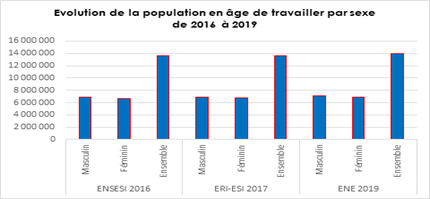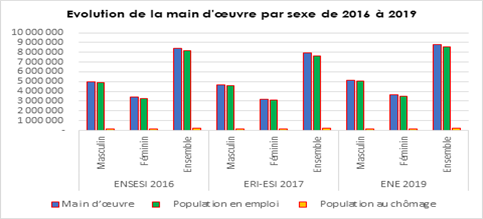The formulation of the National Employment Policy (PNE) 2021-2025 follows the previous cycle of the PNE 2016-2020, which was initiated based on an evaluation by experts from the International Labour Organization (ILO) with the support and contribution of all partners and stakeholders in employment. This evaluation revealed that the current employment situation in Côte d'Ivoire is characterized by a persistence of (i) underutilization of the workforce, particularly among youth, (ii) precarious employment, and (iii) a significant number of informal jobs. This situation is primarily due to a significant imbalance in the labor market, which is explained by the growth in the number of job seekers.
Furthermore, COVID-19 has brought about new forms and methods of work that have not been sufficiently taken into account in our context, such as teleworking.
The PNE 2021-2025, in its formulation, aligns with international standards, particularly the Declaration of Heads of State made at the African Union summit on employment and poverty reduction in Ouagadougou (Burkina Faso) in 2004. At this summit, Heads of State committed to making job creation the essential objective of their economic and social policies at the national, sub-regional, and continental levels, and to promoting the Decent Work Agenda of the International Labour Organization (ILO).
At the national level, the PNE 2021-2025 is part of the new vision of the President of the Republic regarding employment through the program “A Solidarity Côte d'Ivoire” by 2023, particularly concerning pillar II “Creating Wealth as a Source of Employment” and pillar V “Making every Ivorian, regardless of their origins and social conditions, a fulfilled development actor contributing through their work to wealth creation and the development of our beautiful country.”
Thus, the general objective of the PNE 2021-2025 aims to promote access to decent employment for all men and women of working age, including youth and persons with disabilities, by 2025, along with improving the governance of the labor market.
More specifically, it aims to:
- Improve the working and living conditions of workers;
- Accelerate the transition from the informal economy to the formal economy;
- Promote new forms of employment to increase integration opportunities for youth and vulnerable individuals while enhancing their employability;
- Develop decent employment at the local level (decentralized communities);
- Improve the communication and information system of the labor market;
- Establish a sustainable financing mechanism capable of mobilizing significant financial resources for the implementation of the PNE 2021-2025.
The actions implemented under the execution of the PNE 2021-2025 have primarily focused on:
- The creation by decree n°2021-354 of July 7, 2021, and the operationalization of the National Observatory of Employment and Training (ONEF);
- The establishment of the Labor Market Information System (SIMT) by inter-ministerial order n° 0070/MEPS/MEPD/MPJISC of July 30, 2024, concerning the creation, organization, and functioning of the SMIT;
- The creation by decree n°2023-88 of February 15, 2023, and the operationalization of the Socio-Professional Insertion Fund for Persons with Disabilities;
- The creation of the Compendium of Skills of Seniors in Côte d'Ivoire on July 21, 2021, the date of its launch;
- The implementation, since 2020, of directories of measures for job creation and maintenance.
- Working-age population
The working-age population consists of all individuals aged 16 and older. It has been steadily increasing, with a slight overrepresentation of men (50.8% men compared to 48.2% women, according to the results of the National Employment Survey - ENE - 2019).

Sources: Ministry of Employment and Social Protection (MEPS)
Evolution of the working-age population by sex from 2016 to 2019
| Indicators | ENSESI 2016 | ERI-ESI 2017 | ENE 2019 | ||||||
Male | Female | Total | Male | Female | Total | Male | Female | Total | |
| Working-age population | 6,876,617 | 6,719,388 | 13,595,005 | 6,893,168 | 6,736,524 | 13,629,692 | 7,105,284 | 6,871,913 | 13,977,197 |
Sources: Ministry of Employment and Social Protection (MEPS)
- Labor force structure
The labor force consists of the employed population and the unemployed population. It is largely dominated by the employed population (97% compared to 3% of the unemployed population). The employed population is defined as all individuals of working age who, during a short reference period, were engaged in any activity aimed at producing goods or providing services in exchange for remuneration or profit.
According to the results of the ENE 2019, the employed population is more male than female (58.8% men compared to 41.2% women).

Source : Ministry of Employment and Social Protection (MEPS)
Evolution of the labor force by sex from 2016 to 2019
| Indicators | ENSESI 2016 | ERI-ESI 2017 | ENE 2019 | ||||||
Male | Female | Total | Male | Female | Total | Male | Female | Total | |
| Labor force | 4,987,548 | 3,408,959 | 8,396,507 | 4,700,176 | 3,204,929 | 7,905,105 | 5,162,605 | 3,663,091 | 8,825,696 |
| Employed population | 4,869,923 | 3,288,355 | 8,158,278 | 4,565,129 | 3,081,040 | 7,646,169 | 5,037,943 | 3,528,151 | 8,566,094 |
| Unemployed population | 117,625 | 120,604 | 238,229 | 135,047 | 123,889 | 258,936 | 124,662 | 134,940 | 259,602 |
Source : Ministry of Employment and Social Protection (MEPS)
- Underutilization of the workforce
The unemployment rate fluctuates around 3% during the period 2016-2019. The low unemployment rate conceals certain realities of the labor market, including:
- The predominance of informal jobs characterized by low levels of remuneration and profitability, difficult working conditions, and precarious employment;
- The high number of individuals of working age who do not participate in the labor market (potential workforce);
- Underemployment related to working hours.
Thus, the indicators of workforce underutilization that take these dimensions into account are at relatively higher levels. These include, among others, the combined rate of unemployment and underemployment related to working hours (SU2); the combined rate of unemployment and potential workforce (SU3); and the combined rate of unemployment, underemployment related to working hours, and potential workforce (SU4), which stand at 12.3%, 12.9%, and 21.3% respectively in 2019.
The analysis of all these indicators of workforce underutilization, according to gender, reveals discriminatory situations against women. Indeed, in 2019, the unemployment rate among women (3.7%) is higher than that of men (2.4%). Similarly, the combined rate of unemployment, underemployment related to working hours, and potential workforce is higher among women than among men (28.2% compared to 15.9%).
Evolution of underemployment indicators of the labor force from 2016 to 2019
| Indicators | ENSESI 2016 | ERI-ESI 2017 | ENE 2019 | ||||||
Male | Female | Total | Male | Female | Total | Male | Female | Total | |
| Unemployment rate (SU1) | 2.3% | 3.5% | 2.8% | 2.9% | 3.9% | 3.3% | 2.4% | 3.7% | 2.9% |
| Combined rate of unemployment and underemployment related to working hours (SU2) | 12.8% | 18.1% | 14.9% | 11.8% | 12.2% | 12.0% | 9.8% | 15.8% | 12.3% |
| Combined rate of unemployment and potential workforce (SU3) | 10.2% | 22.5% | 15.6% | 7.8% | 18.1% | 12.2% | 9.1% | 17.8% | 12.9% |
| Combined rate of unemployment, underemployment related to working hours, and potential workforce (SU4) | 19.8% | 34.2% | 26.1% | 16.3% | 25.2% | 20.1% | 15.9% | 28.2% | 21.3% |
Source :series of employment surveys conducted between 2016 and 2019
- Characteristics of employment
The labor market in Côte d'Ivoire is characterized by:
- A very high level of informality in jobs, affecting nearly 9 out of 10 jobs;
- A high level of vulnerability in jobs, more pronounced among women (80% on average compared to 60% among men).
Evolution of some indicators characterizing employment from 2016 to 2019 (in %)
| Indicators | ENSESI 2016 | ERI-ESI 2017 | ENE 2019 | ||||||
Male | Female | Total | Male | Female | Total | Male | Female | Total | |
| Informal employment rate | 91.8 | 96.3 | 93.6 | 90 | 94.6 | 91.9 | 85.5 | 94.5 | 89.2 |
| Vulnerable employment rate | 64.9 | 85.6 | 73.1 | 61.8 | 80.9 | 69.5 | 63.1 | 82.5 | 71.1 |
| Proportion of wage employment | 32.5 | 13.3 | 24.9 | 29.3 | 13.9 | 23.1 | 30.7 | 13.6 | 23.7 |
Source : Ministry of Employment and Social Protection (MEPS)
- Situation of youth in the labor market
In general, the situation of youth in the labor market is concerning. Indeed, nearly 3 out of 10 young people are neither employed, nor in education, nor in training, according to the results of the ENE 2019. This reality is more pronounced among women than among men.
To improve this situation, the government has intensified the implementation of the Technical Education and Vocational Training Reform 2016-2025. Additionally, it has initiated the National Strategy for Professional Insertion and Youth Employment (SNIEJ 2021-2025), which aims to help over 3.4 million young people access and maintain sustainable and decent jobs. This involves adopting a set of laws aimed at regulating and promoting youth employment.
Evolution of the proportion of youth neither in employment, nor in education, nor in training from 2016 to 2019 (in %)
| Indicators | ENSESI 2016 | ERI-ESI 2017 | ENE 2019 | ||||||
Male | Female | Total | Male | Female | Total | Male | Female | Total | |
| Proportion of youth aged 16-24 neither in employment, nor in education, nor in training | 20.1 | 45.5 | 32.7 | 27.3 | 29.3 | 28.3 | 16.7 | 38.4 | 27.9 |
| Proportion of youth aged 16-35 neither in employment, nor in education, nor in training | 21.2 | 47 | 35 | 22.4 | 46.4 | 35 | 16 | 38.2 | 27.5 |
Source : Ministry of Employment and Social Protection (MEPS)
- Employment perspectives
Employment perspectives revolve around the following points:
In terms of employment promotion:
- Continuation of the implementation of the National Employment Policy 2021-2025, including related strategies;
- Continuation of the implementation of the Vulnerable Groups Employment Promotion Project;
- Continuation of the implementation of the Decent Work Promotion Project (PPED);
- Continuation of the implementation of the Insertion Project for Vulnerable Persons (PIPV).
In terms of reducing the informal sector:
- Facilitation of the transition of informal sector workers to the formal sector through tax incentives, access to social protection, and technical and financial support programs;
- Extension of social protection coverage to all workers, including those in the informal sector, by establishing flexible and inclusive mechanisms.
In terms of promoting green jobs and the circular economy:
- Promotion of jobs in sectors related to the green economy, such as renewable energy, waste management, and sustainable agriculture;
- Support for businesses adopting sustainability-focused economic models, resource reuse, and waste reduction;
- Promotion and dissemination of jobs and professions in the digital economy;
- Promotion and dissemination of jobs and professions in the blue economy.
In terms of reforming vocational training systems:
- Adaptation of vocational training systems to labor market needs by collaborating with businesses to define required skills;
- Investment in the modernization of vocational training centers, particularly in disadvantaged regions, and integration of digital technologies into curricula.
In terms of supporting SMEs and self-employment:
- Establishment of specific financing mechanisms to support SMEs and micro-entrepreneurs;
- Organization of training and support programs for young entrepreneurs to strengthen their capacities in business management, accounting, and growth strategy.
